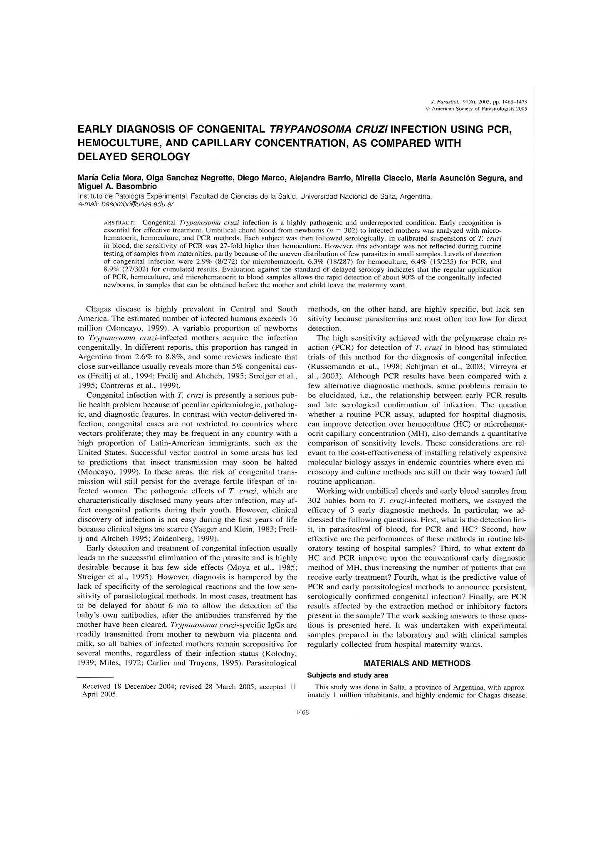Artículo
Early diagnosis of congenital Trypanosoma cruzi infection using PCR, hemoculture, and capillary concentration, as compared with delayed serology
Mora, Maria Celia ; Sánchez Negrette, Olga; Marco, Jorge Diego
; Sánchez Negrette, Olga; Marco, Jorge Diego ; Barrio, Alejandra; Ciaccio, Mirella; Segura, Maria Asuncion; Basombrío, Miguel Ángel Manuel
; Barrio, Alejandra; Ciaccio, Mirella; Segura, Maria Asuncion; Basombrío, Miguel Ángel Manuel
 ; Sánchez Negrette, Olga; Marco, Jorge Diego
; Sánchez Negrette, Olga; Marco, Jorge Diego ; Barrio, Alejandra; Ciaccio, Mirella; Segura, Maria Asuncion; Basombrío, Miguel Ángel Manuel
; Barrio, Alejandra; Ciaccio, Mirella; Segura, Maria Asuncion; Basombrío, Miguel Ángel Manuel
Fecha de publicación:
12/2005
Editorial:
American Society of Parasitologists
Revista:
Journal of Parasitology
ISSN:
0022-3395
e-ISSN:
1937-2345
Idioma:
Inglés
Tipo de recurso:
Artículo publicado
Clasificación temática:
Resumen
Congenital Trypanosoma cruzi infection is a highly pathogenic and underreported condition. Early recognition is essential for effective treatment. Umbilical chord blood from newborns (n = 302) to infected mothers was analyzed with microhematocrit, hemoculture, and PCR methods. Each subject was then followed serologically. In calibrated suspensions of T. cruzi in blood, the sensitivity of PCR was 27-fold higher than hemoculture. However, this advantage was not reflected during routine testing of samples from maternities, partly because of the uneven distribution of few parasites in small samples. Levels of detection of congenital infection were 2.9% (8/272) for microhematocrit, 6.3% (18/287) for hemoculture, 6.4% (15/235) for PCR, and 8.9% (27/302) for cumulated results. Evaluation against the standard of delayed serology indicates that the regular application of PCR, hemoculture, and microhematocrit to blood samples allows the rapid detection of about 90% of the congenitally infected newborns, in samples that can be obtained before the mother and child leave the maternity ward.
Palabras clave:
Trypanosoma
,
Congenital
,
Chagas
,
Argentina
Archivos asociados
Licencia
Identificadores
Colecciones
Articulos(IPE)
Articulos de INST.DE PATOLOGIA EXPERIMENTAL
Articulos de INST.DE PATOLOGIA EXPERIMENTAL
Citación
Mora, Maria Celia; Sánchez Negrette, Olga; Marco, Jorge Diego; Barrio, Alejandra; Ciaccio, Mirella; et al.; Early diagnosis of congenital Trypanosoma cruzi infection using PCR, hemoculture, and capillary concentration, as compared with delayed serology; American Society of Parasitologists; Journal of Parasitology; 91; 6; 12-2005; 1468-1473
Compartir
Altmétricas



